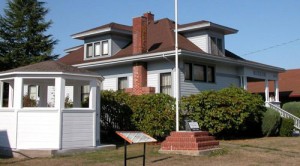Outside the Silverton Country Historical Society museum sits a small, white structure, its many windows indicating what it once was – an aircraft observation post dating to 1942.
Recently placed on South Water Street and renovated, it is a constant reminder to newcomers and old-timers alike of a different, less technological time in our history.
“Observation posts are now being organized in every community west of the Cascade mountains,” states an article in the Silverton Appeal-Tribune dated Oct. 10, 1941. “Silverton has five observation posts and was one of the first communities to organize. They are located in the Silverton Hills, Silver Creek Falls, the Abiqua district, Central Howell and McKee.”
At the end of that month, the Oct. 31, 1941, issue shows a photograph of some of the many volunteers who were already participating in the program.
The United States was readying for war, and the U.S. Army’s aviation section was in charge of making sure no enemy planes were able to penetrate into the country’s interior.
There had to be one post for every 32 square miles and each had to be within 15 seconds of a telephone.
“My guess is there were 100 over western Oregon,” said Jack Hande, 77, a longtime Silverton resident and historical society member. “There were observation posts of all kinds, some in homes. Everybody pretty much cheered them on.”
“It was no secret,” he said. “This was another way we could help with the war effort. In those days everyone was going in one direction…it was different from today. We had a big problem and everyone wanted to solve it. Everyone was in it – we didn’t like it but we wanted to do our part.”
Equipped with only binoculars and their ears, Hande’s mother, Irene, and her children, Jack, then 13, and Jane, 11, were volunteers at this post, located in the Silverton Hills on Tom Skaife’s strawberry farm about 60 feet off Victor Point Road. “I remember I used to ride my bike 2 miles up there,” Hande said.
“If it was cloudy or rainy you could still hear the noise of a passing plane, and you’d call that in. You’d describe the number of engines and the direction it was going in. We never reported an enemy plane, though, and only my mother could do the calling.” Previously, a rectangular shack was used on the spot. It was replaced by this building in 1942, said Hande, and operated from 1942 to 1944 24 hours a day.
“This one was known by a code,” he said. “You’d lift the telephone receiver and were answered at Portland Air Base immediately.”
Wondering what happened to the post, Hande drove by the Schmidt place one day.
“There was the building I recognized as the observation post,” he said. “So I mentioned to the museum it might be good to have.”
Dr. Ralph Schmidt and his wife, Edith, had used the post as a playhouse for their children and their grandchildren, and had maintained it through the years. Hande approached them at that time, but they said they were not ready to let it go.
Later, however, when both the Schmidts had died, their son-in-law, Pat Scott, told Hande the family would be willing to give the historical structure away. Former SCHS president Scott Guenther also had communication with them, and when the society came into extra funds through a grant, the SCHS board of directors approved the post’s acquisition in 2008.
“It was the basic desire of the board to try to preserve this, not necessarily just my own,” said Larry Thomas, the present SCHS president. “But I felt with my experience (as an independent contractor for 20 years), I could make it happen.”
Thomas researched the location of the post and what it would take to move it. “Under it was a patchwork of logs that looked like the original foundation,” he said. “I had a mover from Salem come out, and he said it could be moved.”
But first, back at the museum in Silverton, Thomas needed to move the gazebo-like structure protecting part of a stump saved from Silverton’s historic Old Oak when it was cut down in the late 1800s from the middle of Main Street. The city of Silverton gave him permission to transfer the stump and the gazebo to the city park behind the museum; PGE and a society member donated their time to the moving project.
“On Aug. 1 the moving company brought the post here,” Thomas said. Work had to be done on the 66-year-old structure, which had some dry rot.
“We had to recondition all the windows and replaced two window frames; we painted the windows and the building, inside and out. A local contractor reroofed it, along with the gazebo.”
“We’re in the process of renewing the wood floor, and we plan to put lattice around the base. We will try to redecorate the inside as it was used back then [a small oil stove and electric lights were added to the structure in the 1950s when for a short time it was used during the Korean War], and there will be some memorabilia displays inside.”
“I have been impressed by how many people have memories of that building, and they’ve all been good,” said the museum curator Carolyn Hutton. “I feel it’s a real bonding experience between the museum and the community.”
An informational plaque is installed in front of the aircraft observation post.
Museum visitors can tour the building from 1 p.m. to 4 p.m. on weekends. The historical society’s museum is located at 438 S. Water St., Silverton.
